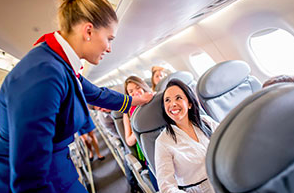Is Airsickness Getting in the Way of Your Busy Lifestyle?
Airsickness is a common form of motion sickness. When you ride in an aircraft, your body may not be used to the sensation of flying through the air. Like traditional motion sickness, airsickness can result in all sorts of uncomfortable symptoms including dizziness, nausea, and lightheadedness. Take a moment to learn more about airsickness as well as how it can be prevented.
What Is Air Sickness?
When flying in an airplane, you may feel as if their body is in two places at once. The inner ear may sense the movement of the plane, speeding through the air at over 400 miles per hour. But at the same time, the eyes see no sign of movement and the body’s muscles are sitting still. Thus, people with a tendency towards motion sickness will start to react out in negative ways, often feeling dizziness, nausea, headaches, sweating and even vomiting.
How to Treat Air Sickness
Compared to carsickness and other forms of motion sickness, airsickness tends to have a more severe effect on the body. The plane speeds along at a faster pace, and getting off the flight is impossible after take off. Fresh air is usually one of the best remedies for motion sickness, but obviously you can’t open a window when you’re cruising through the air. The space is also more confined in an airplane, which can make symptoms feel worse. Turning on the fan above your seat can help with airflow.
You can also try looking out the window to relieve their symptoms. This helps the brain recognize the motion that’s taking place. In a plane, however, you might not have access to a window seat or there might not be anything to see when you look out the window.
If symptoms are severe, a doctor might prescribe a series of low-dose anti-nausea medications (to be taken 30-60 minutes before the flight) or a mild sedative to help curb symptoms mid-flight. You can also try taking a sleeping pill before their flight to help avoid uncomfortable symptoms altogether.
Depending on the airline, the person should try to check-in for their flight as early as possible in order to secure a window seat. If seats are assigned beforehand, they should also book their flight as far in advance as possible to make sure that they have access to a window seat.
Also, looking into natural options for side-effect free motion sickness relief is a great option. One option is Motioneaze. Motioneaze makes it easy to relieve the symptoms of airsickness. A few drops behind the ear relieves motion sickness in just minutes and can make a flight much more enjoyable.



